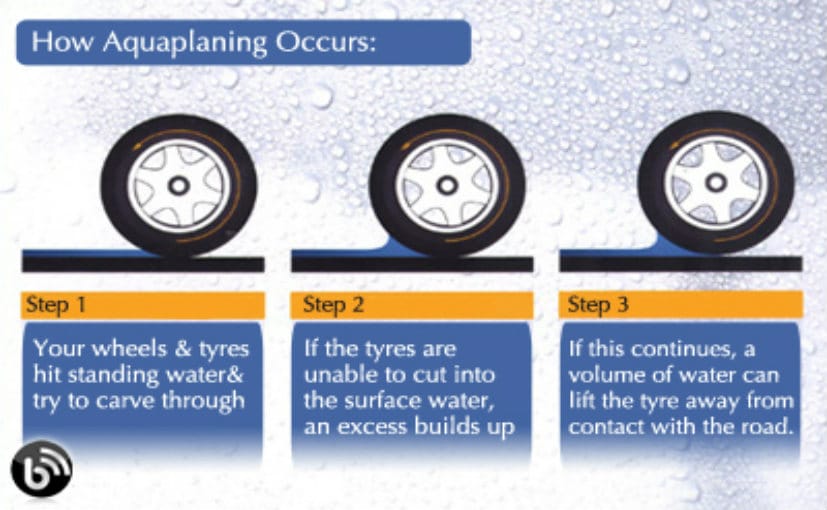What Is Aquaplaning and How to Avoid It?

- Aquaplaning occurs commonly on water-laden roads
- Keeping a calm head is absolutely essential in an 'aquaplaning' situation
- Keep an eye on the condition of the tyres on your car in monsoon
Monsoon is almost upon us and this means water laden roads all over the country. It would be difficult to believe that the rain water, which stays on roads so harmlessly, holds major potential for accidents. All thanks to a phenomenon known as aquaplaning or hydroplaning.
What basically happens is that a thin film of water is formed between the tyres of a car and the tarmac. This happens because the pressure that water lying on the road exerts becomes more than the pressure that the tyres exert on the road. This happens just for a fraction of a second but that is more than enough for you to lose control of the car. Basically, the car loses the grip that the tyres generate from the tarmac. Even steering inputs fail to register and the brakes are rendered useless because the tyres are spinning freely. This means that the car is likely to spin off the road or crash into oncoming traffic, if it is there. Yes! It's danger lurking on a harmless looking road with water on it.
 (Image courtesy: wheelwright.co.uk)
(Image courtesy: wheelwright.co.uk)Prevention is always better than cure
There are ways to reduce the risk of aquaplaning when driving in the rains. For starters, make sure that the tyres on your car are inflated as per the manufacturer's prescription. Underinflated or overinflated tyres will dispel water in a haphazard way, which increases the risk of aquaplaning. Secondly, if you see that the tyres of your car are worn out and have negligible tread, change them, at the earliest. There is nothing worse than a bald tyre on a wet rainy day. It will only serve to make your day even gloomier. Thirdly, if you see standing water on the roads, slow down your speed before you enter the puddle. The lesser the speed, the lesser the risk of aquaplaning. Yes! Everybody loves to splash water all around while driving through a puddle but we suggest you taking it easy. Another way to prevent aquaplaning is if the spray from the tyres of car in front of you suddenly increases, it might mean that the car ahead is experiencing aquaplaning.
How do you know whether your car is experiencing aquaplaning?
In case of aquaplaning, you will feel that the steering has become lighter. The RPMs might rise momentarily. The car might suddenly veer in a different direction than the intent of travel.
What to do in case you find yourself 'aquaplaned'
Keeping a calm head is absolutely essential to deal with aquaplaning. First and foremost, stay away from the brake and the accelerator pedal. Step on either and chances are that you will worsen the situation and make the car go in an uncontrolled skid. Secondly, do not provide any steering inputs. Chances are the moment you regain traction after an aquaplaning moment, you might lose it again because the wheels are facing in the direction opposite to the travel. Grip the steering tight and let the car go in the direction its going. It is best to wait it out than doing anything because usually aquaplaning situations are momentary.
Trending News
Latest News
 car&bike Team | Dec 14, 2025Top-Spec Tata Sierra Accomplished, Accomplished+ Prices RevealedRegardless of the powertrain combination chosen, all Tata Sierra Accomplished+ trims cost upwards of Rs 20 lakh (ex-showroom).2 mins read
car&bike Team | Dec 14, 2025Top-Spec Tata Sierra Accomplished, Accomplished+ Prices RevealedRegardless of the powertrain combination chosen, all Tata Sierra Accomplished+ trims cost upwards of Rs 20 lakh (ex-showroom).2 mins read car&bike Team | Dec 13, 2025Skoda Slavia Facelift Spied Testing Again Ahead Of DebutThe facelifted Slavia is expected to debut in 2026 as Skoda-VW India looks to refresh its India 2.0 range.1 min read
car&bike Team | Dec 13, 2025Skoda Slavia Facelift Spied Testing Again Ahead Of DebutThe facelifted Slavia is expected to debut in 2026 as Skoda-VW India looks to refresh its India 2.0 range.1 min read car&bike Team | Dec 13, 20252026 MG Hector Facelift Interior Previewed Ahead Of DebutLatest teaser video of the upcoming Hector facelift suggests minimal cosmetic changes to the interior as well as reveals a new alloy-wheel design.1 min read
car&bike Team | Dec 13, 20252026 MG Hector Facelift Interior Previewed Ahead Of DebutLatest teaser video of the upcoming Hector facelift suggests minimal cosmetic changes to the interior as well as reveals a new alloy-wheel design.1 min read Jaiveer Mehra | Dec 13, 2025Passenger Vehicle, Two-Wheeler Sales Surge In November 2025: SIAMBoth segments reported a growth in the region of 20 per cent, though year-to-date sales growth in FY2026 was notably flatter at around 3 per cent.1 min read
Jaiveer Mehra | Dec 13, 2025Passenger Vehicle, Two-Wheeler Sales Surge In November 2025: SIAMBoth segments reported a growth in the region of 20 per cent, though year-to-date sales growth in FY2026 was notably flatter at around 3 per cent.1 min read car&bike Team | Dec 12, 2025Nissan Entry MPV Design To Be Unveiled On December 18New MPV to be the first of three new models for India by Nissan, alongside the Tekton and a three-row SUV.1 min read
car&bike Team | Dec 12, 2025Nissan Entry MPV Design To Be Unveiled On December 18New MPV to be the first of three new models for India by Nissan, alongside the Tekton and a three-row SUV.1 min read Jaiveer Mehra | Dec 12, 2025New Mini Convertible Launched At Rs 58.50 LakhDrop-top variant of the iconic Cooper hatchback available in a single Cooper S spec.1 min read
Jaiveer Mehra | Dec 12, 2025New Mini Convertible Launched At Rs 58.50 LakhDrop-top variant of the iconic Cooper hatchback available in a single Cooper S spec.1 min read
 Janak Sorap | Dec 11, 2025Harley-Davidson X440 T First Ride Review: Smarter and SharperHarley-Davidson has taken the X440 and given it a more focused and engaging twist. The result is the X440 T—essentially the same platform but updated in areas that give the motorcycle more appeal and riders more thrill.5 mins read
Janak Sorap | Dec 11, 2025Harley-Davidson X440 T First Ride Review: Smarter and SharperHarley-Davidson has taken the X440 and given it a more focused and engaging twist. The result is the X440 T—essentially the same platform but updated in areas that give the motorcycle more appeal and riders more thrill.5 mins read Shams Raza Naqvi | Dec 10, 20252025 Mini Cooper Convertible Review: More Colour On Indian RoadsThe updated Mini Cooper Convertible is set to be launched in the Indian market in the next few days. We drive it around Jaisalmer for a quick review.1 min read
Shams Raza Naqvi | Dec 10, 20252025 Mini Cooper Convertible Review: More Colour On Indian RoadsThe updated Mini Cooper Convertible is set to be launched in the Indian market in the next few days. We drive it around Jaisalmer for a quick review.1 min read Bilal Firfiray | Dec 8, 2025Tata Sierra Review: India’s New Favourite?Marking its return after a few decades, the reborn Sierra has made everyone sit up and take notice. But is it worth the hype?10 mins read
Bilal Firfiray | Dec 8, 2025Tata Sierra Review: India’s New Favourite?Marking its return after a few decades, the reborn Sierra has made everyone sit up and take notice. But is it worth the hype?10 mins read Girish Karkera | Dec 4, 20252026 Honda Prelude First Drive: Domesticated Civic Type RA sporty-looking coupe built to give customers a taste of performance but not at the expense of everyday practicality.5 mins read
Girish Karkera | Dec 4, 20252026 Honda Prelude First Drive: Domesticated Civic Type RA sporty-looking coupe built to give customers a taste of performance but not at the expense of everyday practicality.5 mins read Seshan Vijayraghvan | Nov 29, 2025Mahindra XEV 9S First Drive Review: Big Electric SUV, Bigger ExpectationsThe XEV 9S lands at a time when the EV crowd is growing fast. It’s a big, born-electric, three-row SUV that starts under 20 lakh. It sits close to the XUV700 in size, but the brief is very different. Here’s what it’s like on the road.11 mins read
Seshan Vijayraghvan | Nov 29, 2025Mahindra XEV 9S First Drive Review: Big Electric SUV, Bigger ExpectationsThe XEV 9S lands at a time when the EV crowd is growing fast. It’s a big, born-electric, three-row SUV that starts under 20 lakh. It sits close to the XUV700 in size, but the brief is very different. Here’s what it’s like on the road.11 mins read































































































































